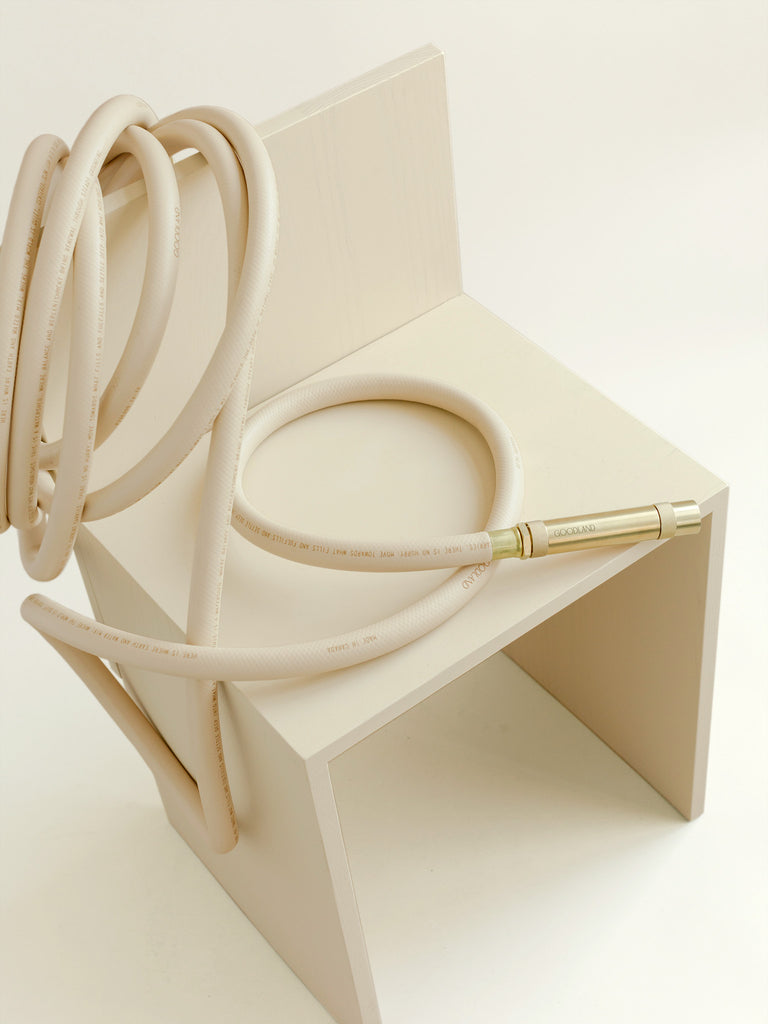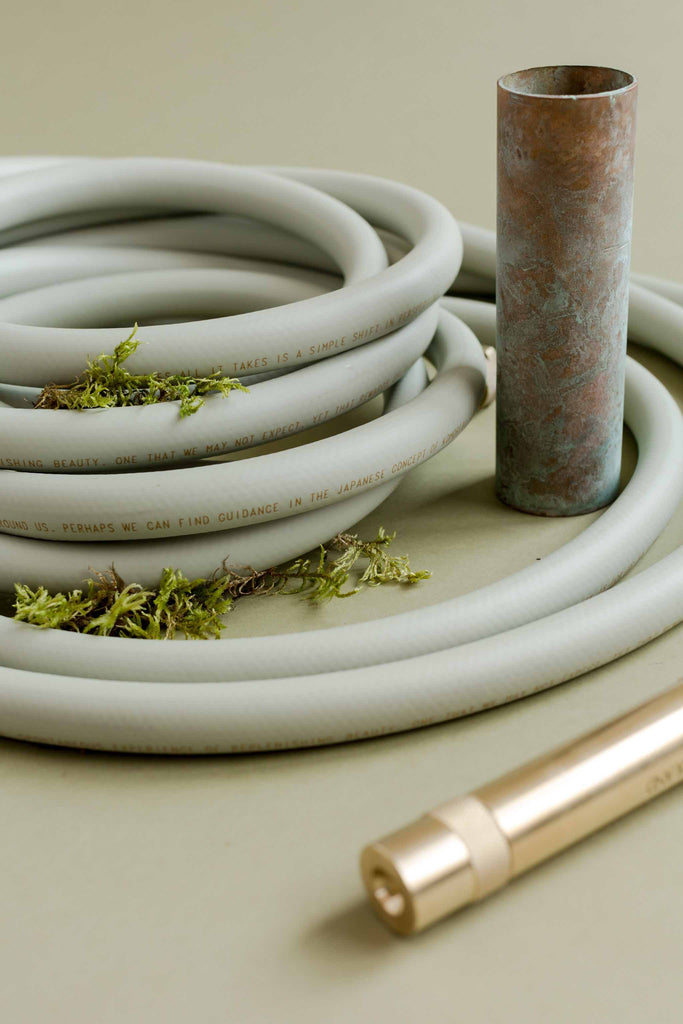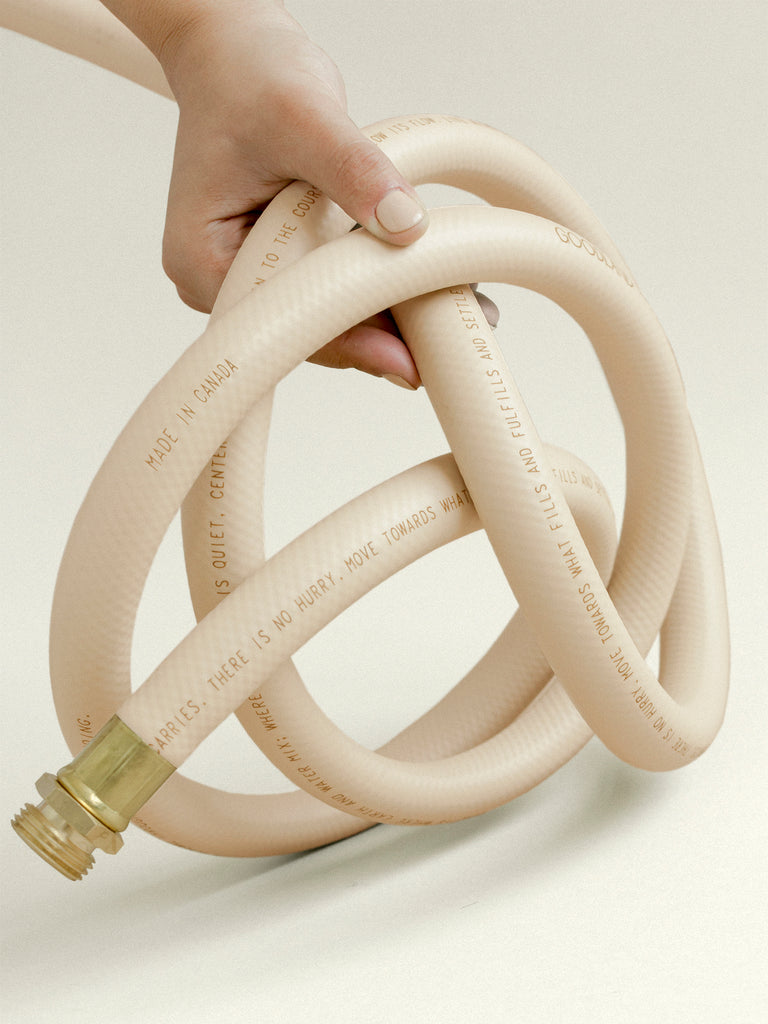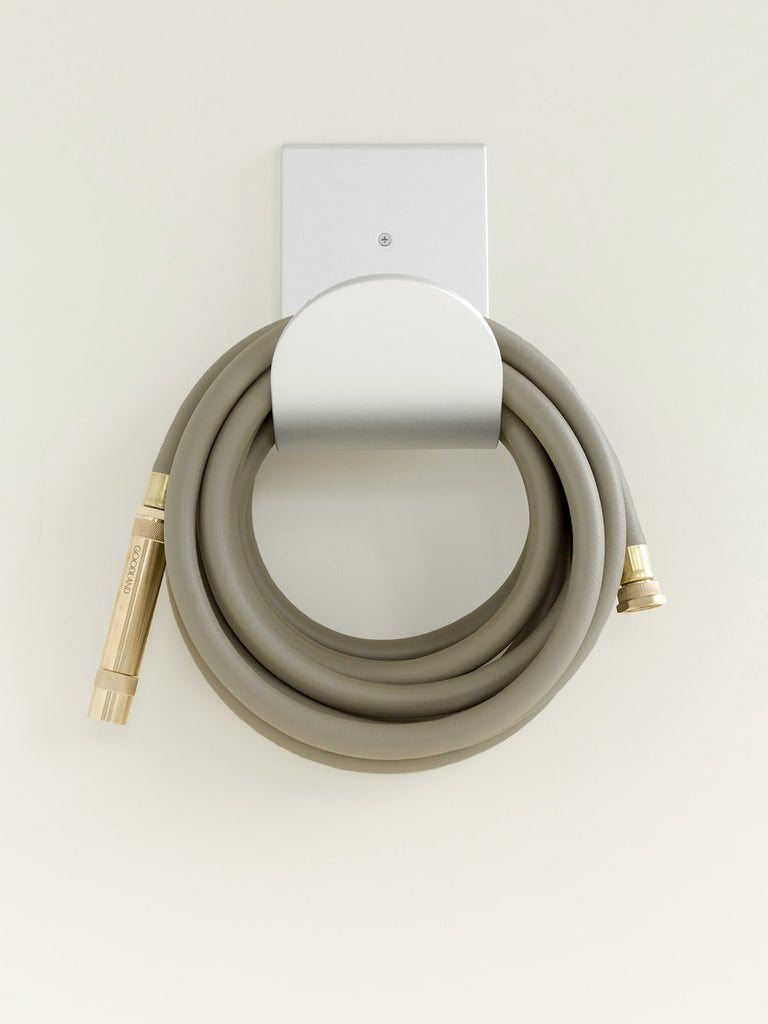If you have a garden, a good garden hose is a household essential. It makes it easier to water your plants, clean your car, wash exterior windows, or even fill up your wood burning hot tub. Your garden hose is something that you’ll use regularly, making it all the more important for it to be durable, well-designed, and a genuine pleasure to use.
Unfortunately, the majority of hoses on the market tend to be designed to be replaced, instead of made to last. A good garden hose should last around 10 years or, ideally, longer—our GOODLAND Everlasting Garden Hose has a lifetime guarantee.

When we created our small batch Everlasting Garden Hose, our team spent months researching and designing to figure out how to create the absolute best garden hose that we could. If you’re in the market for a hose, we’ve put together our research notes—consider this your quick guide to the main points and features you should look out for and keep in mind during your garden hose search.
1 / Garden Hose Size
Hose Length
If you're wondering how to choose a garden hose, one of the main things you’ll need to know is what length of hose you need. Garden hose length can really vary, but most are between 25 and 100 ft long in increments of 25 ft.
The best way to determine how much hose you’ll need is to measure the distance from the water source to the farthest spot on your property that requires water. Keep in mind as the hose length increases, water pressure diminishes and the weight of the hose increases. Be realistic, but conservative: you don’t want to end up lugging around a heavier hose for your garden than you need.
If you occasionally require a longer hose, we recommend buying two shorter lengths and attaching them only when needed to avoid lugging around a heavy hose—especially if it’s a high quality, heavyweight garden hose.
Inside Diameter or Thread Size
The inside diameter of a hose - also known as garden hose thread size - includes ¾ inch, ⅝ inch and ½ inch.
In North America the most common thread size is ⅝ inch. This standard size is widely used for most garden and home tasks. It easily connects hoses to most faucets, spigots, and watering tools. A tapered thread design should provide a secure seal when connected, helping to prevent leaks and wayward sprays.
A bigger hose width like ¾ inch will carry more water at once but will be heavier in weight, especially when filled with water. To get a sense of which garden hose diameter is right for you, consider what you’ll be regularly using this watering tool for. Lightweight hoses with a smaller diameter are less efficient, and tend to be better if you’re mainly watering a small garden. If you plan on using a hose for cleaning, sprinklers, etc., consider a wider diameter that can more efficiently get the job done.

2 / Types of Garden Hose
A second consideration is the purpose of the hose and how you need it to function. Besides the classic garden hose, there are specialty designs as well as different materials and weights available.
Categories
If you’ve been researching online or strolling the aisles of the gardening store, you’ve seen the mezmerizing number of garden hoses on the market. This list covers some of the most popular types:
Standard Hose
The run-of-the-mill big box store garden hose, which is typically lightweight, made from vinyl or rubber, tends to kink, and breaks down after a few years. These hoses are inexpensive and often not drinking water safe.
Flat Hose
Looking like a smaller version of what firefighters use, flat hoses are compact, lightweight, and easy to store but deliver water with less pressure compared to traditional round hoses. They’re best suited to situations where space is limited.
Garden Soaker Hose
Designed for watering gardens and flower beds, soakers have tiny pores along the length of the hose that allow water to seep out slowly, delivering water directly to the roots with minimal waste. These can be left in beds for extended periods for ease of watering, but will deteriorate quickly in sunny climates.
Commercial Hose
These hoses are also heavy duty, especially designed for professional use, agricultural or industrial watering tasks. Made of materials like rubber or reinforced vinyl, commercial hoses can handle extensive, continuous use and/or hot water.
Weights
The materials, construction, and length will affect the weight of a garden hose. Depending on the user, weight might be an essential consideration.
Lightweight Garden Hose
Specifically designed to be easy to use and hauled around at longer lengths on a daily basis, lightweight hoses vary in quality and materials. Look for a higher quality brand which will be stronger and longer-lasting, but keep in mind lightweight hoses aren’t always suited to colder climates.
Heavy Duty Garden Hose
This hose type is structured in layers to be thicker, more durable, and kink-free. The solid construction is reinforced to prevent bursting, breaking, and cracking from weathering. Heftiness at longer lengths requires some strength to manage. Heavy duty hoses usually feature high-quality metal fittings which won’t break and require replacing. Our Everlasting Garden Hose falls into this category.

3 / Hose Material
Garden hoses are made from a variety of materials, from cheap vinyl garden hoses to more expensive PVC. But, it’s actually a bit more complicated than this. The chemical formula used in those material compounds can vary from hose to hose. So, even if two hoses are advertised to be made with the same or similar materials (e.g. thermoplastic), they can still be different levels of quality—making it all the more important to look for guarantees or read reviews before you make your purchase.
In addition, water hoses are constructed in layers (plies), from 1-ply to 6-ply. The types of materials used in the layers will make a difference in performance and, of course, weight.
Vinyl
These are typically the most affordable option. They’re lightweight but kink easily, are less durable than other materials, and have a short lifespan. Higher quality vinyl will offer better kink resistance and longevity.
Rubber
Often called “medium duty” hoses, rubber is more durable, flexible, and less likely to kink compared to vinyl hoses. They’re also more resistant to hot water, making them suitable for tasks like washing cars and outdoor furniture.
Stainless Steel
Durable, flexible, weatherproof, and resistant to corrosion, stainless steel is a relatively lightweight and long-lasting solution for gardens. However, steel isn’t generally suitable for drinking water, hot water (it’s conductive), or colder temperatures which cause it to become more rigid.
PVC
Ranging in weights, PVC is a type of vinyl that is more resistant to breaking down. These hoses are lightweight, flexible, and durable. They are commonly used for light to moderate watering tasks.
Reinforced
This hose features layers of reinforcement materials to enhance its strength, durability, and resistance to pressure and kinking. In addition to the materials listed above, the plies consist of one or more other materials such as textile (e.g. polyester or nylon), mesh, wire, and/or fibre. Reinforced are the most expensive types of watering hose, and are often backed by lifespan guarantees.
Our GOODLAND Everlasting Garden Hose uses a three-layer construction to ensure serious durability. The inner seamless PVC tube is specifically formulated for resistance against oils and mild chemicals, and also helps keep the hose flexible in low temperatures. A mid-layer of ballistics-grade high-tensile spiraled polyester yarn helps to further reinforce the hose. Our outer layer has a smooth matte finish, and is made from a proprietary thermoplastic compound that’s designed to protect against abrasion, sunlight, ozone, cracking, and mild chemicals. The short version? It’s designed to really, really last.

4 / Kink Resistance
One of the main problems that can come up with garden hoses is kinking. A poor quality garden hose typically made of single-ply vinyl or plastic can be more prone to kinks—or sharp bends in the hose that prevent the water from flowing evenly and effectively. When this happens, you have to retrace your steps to straighten out the hose. If the water is on full flow, sometimes a bend in the hose will cause the hose to blow apart from the faucet fitting. Over time these kinks can crack and leak.
A kink resistant hose differs from other garden hoses in material and construction. Material plays an important role in determining performance, influencing factors such as kink memory, resilience, and hardness.
Kink memory, determined by a material's ability to recover or spring back from compression, affects its resistance to kinking and can indicate better resilience. Softer materials are more prone to folding and kinking, emphasizing the need for a firmer hose.
In terms of hose construction, look for wall thickness and a reinforcement layer. In general, three-ply thicker-walled garden hoses are more durable and resistant to contortions. Thinner-walled hoses are lightweight, flexible, more affordable—but kink easily and/or will shortly deteriorate. The woven reinforcement layer inside the hose provides support against internal or external pressure and creates a more durable structure.
Another common issue with garden hoses is that many become rigid and perform worse in colder temperatures. If you live somewhere where the temperatures get cold, consider investing in a hose that’ll function well even at chilly temperatures. This is why we designed our small batch Everlasting Garden Hose to endure cold Canadian winters—it can be used between -25°C (-13°F) and 65°C (149°F).

5 / Hose Fittings
Garden hose fittings are connectors that allow you to attach your garden hose to faucets, watering tools, and other hoses. When picking a garden watering hose, don’t neglect these—having durable, secure fittings can help your hose last and avoid pesky leaks.
Metal fittings are preferred for their durability and reliability. Brass fittings in particular are corrosion-resistant, can withstand high water pressure, and are less likely to leak or crack compared to plastic fittings. Brass resists cross-threading when connecting to faucets or tools, and lasts longer than aluminum threads. Brass often includes options like quick-connect fittings and nozzle adapters.
Make it Last
A few simple habits can also help extend the life of your garden hose. Here are a few best practices that we recommend for caring for your garden hose:
- Stretch out and straighten your hose before looping it up
- Gather it into 2-3’ loops when not in use to help prevent damage
- Store the hose in a protected area against the house or in a shed to help the material last longer
- When temperatures are below freezing, be sure to empty the water from your hose and store it properly
- Invest in quality hose accessories, like a durable hose nozzle, hose hanger, shut-off valve, and more
Once you have your hose, learn how to prepare it for the winter season.



